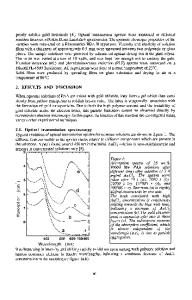Poly (acrylic acid) - mediated soft template synthesis of Poly (3, 4-ethylenedioxythiophene)-based conducting polymer na
- PDF / 685,194 Bytes
- 6 Pages / 612 x 792 pts (letter) Page_size
- 108 Downloads / 395 Views
Poly (acrylic acid) - mediated soft template synthesis of Poly (3, 4-ethylenedioxythiophene)based conducting polymer nanostructures for supercapacitor applications Punya A.Basnayaka1,2, Manoj K. Ram2,3, Lee Stefanakos2,4 and Ashok Kumar1,2 1
Department of Mechanical Engineering, 2 Clean Energy Research Center, 3Nanotechnology
Research and Education Center, 4Department of Electrical Engineering, University of South Florida, 4202 E Fowler Avenue, ENB 118, Tampa, FL, 33620 [email protected], [email protected], [email protected], [email protected] Abstract In the present study, poly (3, 4-ethylenedioxythiophene) (PEDOT) nanostructures were obtained by oxidative polymerization of monomer ‘3, 4-ethylenedioxythiophene’ in the presence of poly (acrylic acid) (PAA) in FeCl3 as an oxidizing agent. The PEDOT nanostructures were characterized using the Fourier Transform Infrared Spectroscopy (FTIR), Scanning Electron Microscopy (SEM) and Transmission Electron Microscopy (TEM) techniques respectively. The morphology of PEDOT nanostructures revealed flowerlike-shape agglomerates with an increase in the concentrations of PAA. The SEM, TEM and FTIR studies revealed that the presence of PAA could only induce a change in morphology during polymerization, but could not influence the molecular structure of the PEDOT nanostructures. The synthesized PEDOT nanostructures were used as electrode material for supercapacitor. The electrochemical capacitive properties of the PEDOT nanostructures were investigated with the Cyclic Voltammetry (CV), galvanostatic charge–discharge and electrochemical impedance spectroscopy (EIS) techniques in the threeelectrode cell system. The capacitance of the PEDOT electrode was measured in 0.1M LiClO4 and 2M H2SO4 electrolytes. The highest specific capacitance value of 215F/g for a PEDOT nanostructured electrode was calculated in 1 M H2SO4 electrolyte. Keywords: soft-template synthesis, conducting polymers, specific capacitance 1. Introduction Supercapacitors exhibit higher power compared to dielectric capacitors, and are associated with good cyclability[1]. They are useful in power electronic systems in automotive and modern commercial systems, and military portable electronics[2]. There are mainly three types of supercapacitors based on carbon, metal oxide, and conducting polymer (CPs) materials [2]. However, conductive polymers have been intensively investigated as electrode materials for
supercapacitors, because of their excellent electrochemical reversibility, fast switching between redox states, high conductivity in a doped state, mechanical flexibility, low toxicity and low cost[2-4]. Polyaniline (PANI), Polypyrrole (PPy), and Polythiophene (PTh) CPs have been extensively studied for supercapacitor applications[3]. Further, our previous study on supercapacitor applications of PANI and its derivatives have drawn the conclusion that the capacitance is dependent on the conductivity of PANI derivative CPs[5]. In particular, Polyethylenedioxythiophene (PEDOT) is a good candidate for supercapacitor electr
Data Loading...











